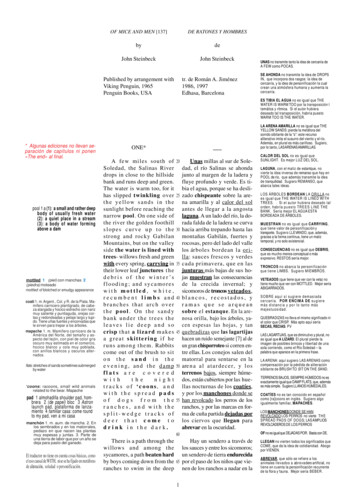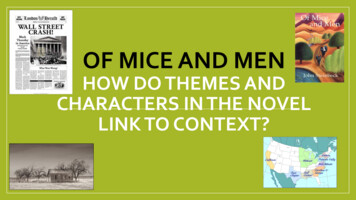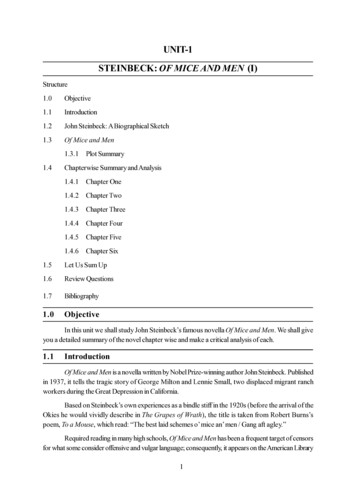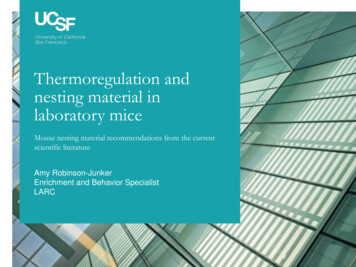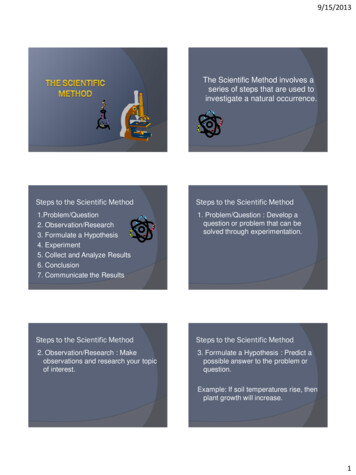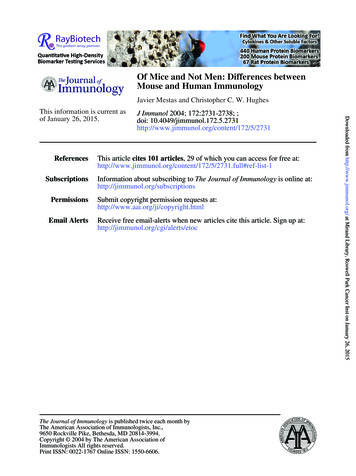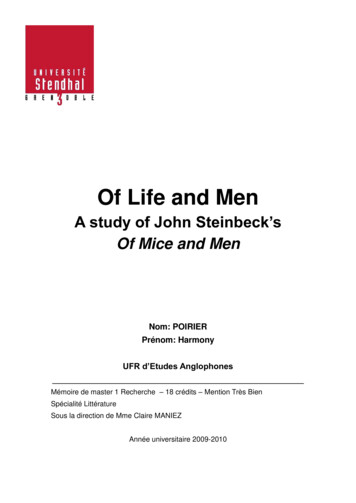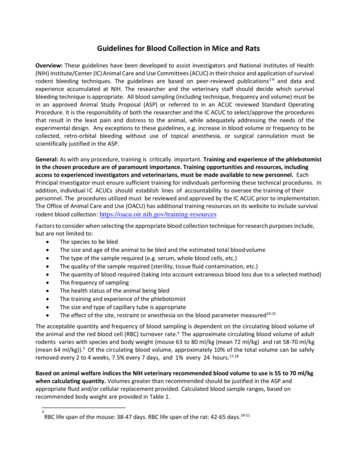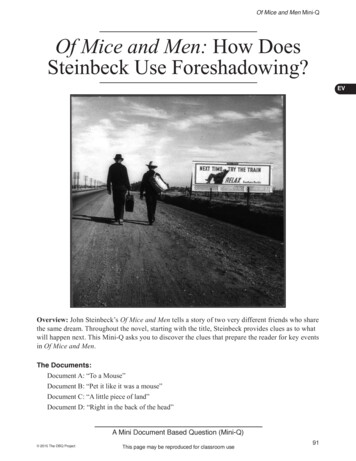
Transcription
Of Mice and Men Mini-QOf Mice and Men: How DoesSteinbeck Use Foreshadowing?EVOverview: John Steinbeck’s Of Mice and Men tells a story of two very different friends who sharethe same dream. Throughout the novel, starting with the title, Steinbeck provides clues as to whatwill happen next. This Mini-Q asks you to discover the clues that prepare the reader for key eventsin Of Mice and Men.The Documents:Document A: “To a Mouse”Document B: “Pet it like it was a mouse”Document C: “A little piece of land”Document D: “Right in the back of the head”A Mini Document Based Question (Mini-Q) 2015 The DBQ ProjectThis page may be reproduced for classroom use91
Of Mice and Men Mini-QHook Exercise: ForeshadowingDirections: Working with a partner or in a small group, look at the cartoon and answer thequestions below.1. Who is teaching the “class” in the cartoon below?EV2. What term is this “teacher” discussing?3. What do you see in this cartoon that can help you figure out the meaning of “foreshadowing”?4. What is your best guess of what “foreshadowing” means? 2015 The DBQ ProjectThis page may be reproduced for classroom use93
Background EssayOf Mice and Men Mini-QOf Mice and Men: How Does Steinbeck Use Foreshadowing?Of Mice and Men is a short book that tells a and then to apply those ideas to the novel. Yourpowerful story. It is a tale of two unlikely friends— first step, then, will be to read an edited versionof “To a Mouse” in Document A.small, intelligent George and enormous but childSteinbeck also sets up two important ideas inlike Lennie—travelling through California duringthe book’s opening pages. In the first paragraph,the 1930s. George and Lennie are migrant workers. They take on temporary jobs at different animals scurry onto the scene: “a lizard Rabranches in an effort to make enough money to buy bits dogs from the ranches and deer .”a place of their own. At their new job, they meet The title has already clued the reader into theimportance of animalsa cast of characters: Canin this book, for “mice”dy, the one-handed oldare right there with the“swamper” who cleans“men,” and the presencethe bunk house; Slim, aof animals in the firstman of God-like wisdomparagraph makes thiswho is described as thepoint even more strong“prince of the ranch”;ly. In the next paragraph,Crooks, the AfricanSteinbeck introduces aAmerican stable hand,second idea. Momentsliving a solitary life onbefore George and Lenthe ranch because of hisnie literally walk into therace; Curley, the boss’spicture, we see an imagehostile and aggressiveof “a path beaten hard byson; and Curley’s nameboys coming down fromless wife, a womanthe ranches,” “an ash piledesperate for attention.made by many fires,” andThings start out wella “limb worn smoothenough, and Candy ofby men who have sat onfers to put up money andPhotographofJohnSteinbeck,c.1935it.” This beaten path, thisjoin George and Lennieash pile, and this smoothin their dream of buyingtheir own farm. Quickly, though, the book begins limb are evidence that George and Lennie are notthe first men to come to this place, and they willto move towards its disastrous conclusion—andif they’ve been paying attention, readers see it not be the last. In other words, Steinbeck is precoming. Although Of Mice and Men is short, it is paring us for a story that is universal.Perhaps the most important structural elecarefully crafted.In this American classic, Nobel Prize- ment in Of Mice and Men is foreshadowing.winning author John Steinbeck uses several Foreshadowing is a device used by an author tostructural elements. For one, the title, Of Mice provide clues of what is to come. Just as omiand Men, is an allusion, meaning it was taken nous clouds alert us that a thunderstorm is on itsfrom another work. Steinbeck borrowed his title way, small disasters and seemingly insignificantfrom the poem, “To a Mouse,” by Scottish farmer events prepare the reader for larger disasters onand poet, Robert Burns. Writers use allusions as a the horizon. As you read the documents that folshort-cut to a set of ideas. By taking his title from low, your job is to discover the clouds and ana well-known poem, Steinbeck is asking readers swer the question: Of Mice and Men: How doesto recall what that poem contains and suggests, Steinbeck use foreshadowing? 2015 The DBQ ProjectThis page may be reproduced for classroom use95EV
Of Mice and Men Mini-QBackground Essay Questions1. Of Mice and Men tells the story of what two friends? What are they hoping to do?EV2. Name five other characters in the novel.3. Who is the author of Of Mice and Men? Which prestigious prize did he win?4. Where does the title, Of Mice and Men, come from?5. What two ideas does Steinbeck set up in the first pages of the book?6. Define these terms:migrant workersallusionuniversalforeshadowingominous 2015 The DBQ ProjectThis page may be reproduced for classroom use97
Of Mice and Men Mini-QUnderstanding the Question and Pre-BucketingUnderstanding the Question1. What is the analytical question asked by this Mini-Q?EV2. Which terms in the question need to be defined?3. Rewrite the question in your own words.Pre-BucketingDirections: Using any clues from the Mini-Q question and the Background Essay, establish generalanalytical categories and label the buckets. 2015 The DBQ ProjectThis page may be reproduced for classroom use99
Of Mice and Men Mini-QDocument A: “To a Mouse”Source: Robert Burns, “To a Mouse” (edited), 1785.Note: This poem was written when the poet, who was also a farmer, turned up a mouse’s nest while plowing a field. Thisis Burns’s apology to the mouse, and has been translated from the original Scottish. The poem in its entirety iseight stanzas long, but only four stanzas are provided here.EVSmall, sleek, cowering, timorous beast,O, what a panic is in your breast!You need not start away so hastyWith hurrying scamper!I would be loath to run and chase you,With murdering plough-staff. That small bit heap of leaves and stubble,Has cost you many a weary nibble!Now you are turned out, for all your trouble,Without house or holding,To endure the winter’s sleety dribble,And hoar-frost cold. Your small house, too, in ruin!Its feeble walls the winds are scattering!And nothing now, to build a new one,Of coarse grass green!And bleak December’s winds coming,Both bitter and keen!But Mouse, you are not alone,In proving foresight may be vain:The best laid schemes of mice and menGo often askew,And leaves us nothing but grief and pain,For promised joy! Document Analysis1. Besides being a poet, what was Robert Burns’s other profession?2. In the first stanza, why is the mouse feeling “panic”? Why does the speaker in the poem say themouse doesn’t need to run away?3. What is the state of the mouse’s house? What will happen to the mouse now?4. Find the line(s) in which the title, Of Mice and Men, appears. Write the complete sentence (afterthe colon) here.5. In what way have the “schemes” (meaning “plans”) of the mouse gone “askew” (meaning “offtrack”)?6. Since Steinbeck chose Of Mice and Men as the title for his novel, what should we expect willhappen to the “men” (meaning all humans) in the novel? 2015 The DBQ ProjectThis page may be reproduced for classroom use101
Of Mice and Men Mini-QDocument B: “Pet it like it was a mouse”Source: John Steinbeck, Of Mice and Men, 1937.Story Note: George is reminding Lennie why they had to leave their last job in the town of Weed.“Jus’ wanted to feel that girl’s dress—jus’ wanted to pet it like it was a mouse— Well, how the helldid she know you jus’ wanted to feel her dress? She jerks back and you hold on like it was a mouse.She yells and we got to hide in a irrigation ditch all day with guys lookin’ for us, and we got to sneakout in the dark and get outta the country. All the time somethin’ like that—all the time.” (Chapter 1)EVStory Note: Lennie is alone in the barn while the other men are playing horseshoes.Lennie sat in the hay looked at a little dead puppy that lay in front of him. Lennie looked at it for along time, and then he put out his huge hand and stroked it, stroked it clear from one end to the other.And Lennie said softly to the puppy, “Why do you got to get killed? You ain’t so little as mice. Ididn’t bounce you hard.” (Chapter 5)Story Note: After the death of the puppy, Curley’s wife sits with Lennie in the barn. When he tells her about his love ofpetting soft things—such as mice, puppies, and rabbits—she offers her hair for him to touch.Lennie’s big fingers fell to stroking her hair.“Don’t you muss it up,” she said.Lennie said, “Oh! That’s nice,” and he stroked harder. “Oh, that’s nice.”“Look out, now, you’ll muss it.” And then she cried angrily, “You stop it now, you’ll mess it all up.”She jerked her head sideways, and Lennie’s fingers closed on her hair and hung on. “Let go,” she cried.“You let go!”Lennie was in a panic. His face was contorted. She screamed then, and Lennie’s other hand closedover her mouth and nose. “Please don’t,” he begged. “Oh! Please don’t do that. George’ll be mad.”She struggled violently under his hands. Her feet battered on the hay and she writhed to be free;and from under Lennie’s hand came a muffled screaming. Lennie began to cry with fright. “Oh! Pleasedon’t do none of that,” he begged. “George gonna say I done a bad thing. He ain’t gonna let me tendno rabbits.” He moved his hand a little and her hoarse cry came out. Then Lennie grew angry. “Nowdon’t,” he said. “I don’t want you to yell. You gonna get me in trouble jus’ like George says you will.Now don’t you do that.” And she continued to struggle, and her eyes were wild with terror. He shookher then, and he was angry with her. “Don’t you go yellin’,” he said, and he shook her; and her bodyflopped like a fish. And then she was still, for Lennie had broken her neck. (Chapter 5)Document Analysis1. What happened in Weed that made it necessary for George and Lennie to “hide” and “sneak”away? What does George say to indicate that things like this have happened before?2. What animals does Lennie like to pet? Why does he like to pet them?3. How does the puppy die?4. How does Curley’s wife die?5. How does Steinbeck use foreshadowing to signal that Curley’s wife will die? Give at least twospecific examples. 2015 The DBQ ProjectThis page may be reproduced for classroom use103
Of Mice and Men Mini-QDocument C: “A little piece of land”Source: John Steinbeck, Of Mice and Men, 1937.Story Note: Before they arrive at their new job, Lennie and George spend the night alone by the water. Lennie urgesGeorge to describe the little farm they plan to buy “like you done before.”“Go on, George! Tell about what we’re gonna have in the garden and about the rabbits in thecages and about the rain in the winter and the stove, and how thick the cream is on the milk likeyou can hardly cut it. Tell about that, George.”“Why’n’t you do it yourself? You know all of it.”“No you tell it. It ain’t the same if I tell it. Go on George. How I get to tend the rabbits.”“Well,” said George, “we’ll have a big vegetable patch and a rabbit hutch and chickens. Andwhen it rains in the winter, we’ll just say the hell with goin’ to work, and we’ll build up a fire inthe stove and set around it an’ listen to the rain comin’ down on the roof—Nuts!” He took outhis pocket knife. “I ain’t got time for no more.” (Chapter 1)Story Note: Lennie is talking with Crooks, the stable hand, about their plan to get their own farm. A bindle is a little bundleof possessions, often carried on the end of a stick.“You’re nuts.”“We are too. You ast George.”“You’re nuts.” Crooks was scornful. “I seen hunderds of men come by on the road an’ onthe ranches, with bindles on their back an’ that same damn thing in their heads. Hunderds ofthem. They come, an’ they quit an’ go on; an’ every damn one of ’em’s got a little piece ofland in his head. An’ never a God damn one of ’em ever gets it.” (Chapter 4)Story Note: After Lennie kills Curley’s wife, George and Candy are discussing what they will do next.Now Candy spoke his greatest fear. “You an’ me can get that little place, can’t we,George? You an’ me can go there an’ live nice, can’t we, George? Can’t we?”Before George answered, Candy dropped his head and looked down at the hay. He knew.George said softly, “—I think I knowed from the very first. I think I knowed we’d neverdo her.” (Chapter 5)Document Analysis1. In the first excerpt, as he has “done before,” what does George describe to Lennie?2. At the end of the first excerpt, George breaks off suddenly, saying he “ain’t got time for nomore.” Why do you think George stops his description so abruptly?3. Does Crooks think Lennie and George will get their own “little piece of land”? Explain his reason.4. In the final excerpt, what is it that George “knowed from the very first”?5. How does Steinbeck use foreshadowing to hint that George and Lennie will not get their ownfarm? Find two examples, one from the first excerpt and another from the second excerpt. 2015 The DBQ ProjectThis page may be reproduced for classroom use105EV
Of Mice and Men Mini-QDocument D: “Right in the back of the head”Source: John Steinbeck, Of Mice and Men, 1937.Story Note: Carlson, one of the ranch hands, is complaining about Candy’s old dog.“Look, Candy. This ol’ dog jus’ suffers hisself all the time. If you was to take him out and shoothim right in the back of the head—” he leaned over and pointed, “—right there, why he’d never knowwhat hit him.”Candy looked about unhappily. “No,” he said softly. “No, I couldn’ do that. I had ’im too long.”“He don’t have no fun,” Carlson insisted. “And he stinks to beat hell. Tell you what. I’ll shoot himfor you. Then it won’t be you that does it.”Candy threw his legs off his bunk. He scratched the white stubble whiskers on his cheeknervously. “I’m so used to him,” he said softly. “I had him from a pup.”“Well, you ain’t bein’ kind to him keepin’ him alive,” said Carlson. “Look, Slim’s bitch got a litterright now. I bet Slim would give you one of them pups to raise up, wouldn’t you, Slim?”The skinner had been studying the old dog with his calm eyes. “Yeah,” he said. “You can have apup if you want to.” He seemed to shake himself free for speech. “Carl’s right, Candy. That dog ain’tno good to himself. I wisht somebody’d shoot me if I got old an’ a cripple.”Candy looked helplessly at him, for Slim’s opinions were law. “Maybe it’d hurt him,” hesuggested. “I don’t mind takin’ care of him.”Carlson said, “The way I’d shoot him, he wouldn’t feel nothing. I’d put the gun right there.” Hepointed with his toe. “Right back of the head. He wouldn’t even quiver.” (Chapter 3)EVStory Note: After Carlson shoots Candy’s dog, Candy asks George and Lennie if he can join them in buying their littlepiece of land. Candy goes on to discuss the shooting of his dog.“I oughtta of shot that dog myself, George. I shouldn’t oughtta of let no stranger shoot my dog.”(Chapter 3)Story Note: After Lennie kills Curley’s wife, Curley is searching for Lennie in order to shoot him painfully “in the guts.”George finds Lennie at their agreed-upon meeting place “in the brush” where he again tells Lennie about the farmthey plan to buy.And George raised the gun and steadied it, and he brought the muzzle of it close to the back ofLennie’s head. The hand shook violently, but his face set and his hand steadied. He pulled the trigger.The crash of the shot rolled up the hills and rolled down again. Lennie jarred, and then settled slowlyforward to the sand, and he lay without quivering. (Chapter 6)Document Analysis1. Why does Carlson offer to shoot Candy’s dog?2. How does Carlson say he will shoot the dog?3. Why does Candy tell George that he “oughtta of shot that dog myself”?4. Why does George shoot Lennie?5. How does George shoot Lennie?6. How does Steinbeck use foreshadowing to suggest how Lennie will die? Be specific. 2015 The DBQ ProjectThis page may be reproduced for classroom use107
Of Mice and Men Mini-QBucketing—Getting Ready to WriteBucketingLook over all the documents and organize them into your final buckets. Write final bucket labelsunder each bucket and place the letters of the documents in the buckets where they belong.Remember, your buckets are going to become your body paragraphs.Thesis Development and Road MapOn the chickenfoot below, write your thesis and your road map. Your thesis is always an opinion andanswers the Mini-Q question. The road map is created from your bucket labels and lists the topicareas you will examine in order to prove your thesis. 2015 The DBQ ProjectThis page may be reproduced for classroom use109EV
Of Mice and Men Mini-QFrom Thesis to Essay WritingMini-Q Essay Outline GuideUnit TitleEVParagraph #1GrabberBrief and relevant plot summaryRestating the question with key terms definedThesis and Road MapParagraph #2Baby Thesis for bucket oneEvidence: Supporting detail and quotation from document with document citationArgument: Connecting evidence to the thesisParagraph #3Baby Thesis for bucket twoEvidenceArgumentParagraph #4Baby Thesis for bucket threeEvidenceArgumentParagraph #5Baby Thesis for bucket fourEvidenceArgumentParagraph #6Conclusion: Restatement of main idea, along with a fresh insight or wrinkle 2015 The DBQ ProjectThis page may be reproduced for classroom use111
Of Mice and Men ini-Overview: John Steinbeck’s Of Mice and Men tells a story of two very different friends who share the same dream. Throughout the novel, starting with the title, Steinbeck provides clues as to what will happen next. This Mini-Q asks you to

